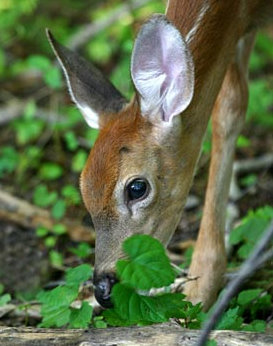What do deer eat? Deer eat mostly browse (leaves, twigs, shoots of woody plants and vines) and forbs (weeds and other broadleaf flowering plants). They do eat some grass, but only when it is young, green, and succulent. Sheep, goats, and exotic game species compete directly with the whitetail for preferred deer foods. Deer food shortages usually occur during late summer and winter months.
Adequate forage is usually available during the spring and fall seasons because of mild temperatures and increased rainfall. A variety of foods and habitat types is essential to good deer production and survival.
Deer eat a variety of plants, and different plant species become more important at different times of the year and importance can even vary year-to-year depending upon environmental conditions. The following plants are examples of some good deer foods which are readily eaten by deer when and where they are available.

Browse:oak leaves and acorns, yaupon, greenbriar, hackberry, mulberry, sumac, hawthorns, poison oak, American beautyberry, wild cherry and plum, wild grape, honeysuckle, dogwood, elm, blackberry and dewberry, acacias, walnut, and chinaberry.The will utilize additional plants species depending upon the area you are located.
Forbs: Illinois bundle flower, euphorbias, bayflower, tickclovers, clover, verbena, wild lettuce, wild onions, old man’s beard, wildbean, snoutbean, lespedezas, spiderwort, vetches, lamb’s quarters, plantain, groundcherry, pigweed, carelessweed, and partridge pea.
Grasses: rescue grass, wintergrass, witchgrass, panic grasses, sedges, and rushes, as well as wild and cultivated rye, oats, and wheat.
